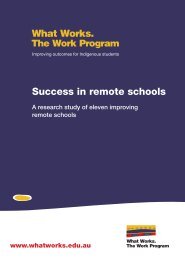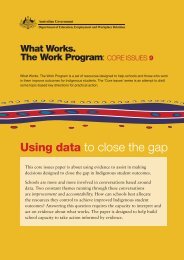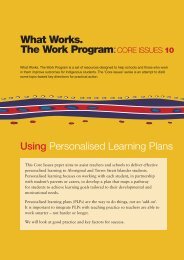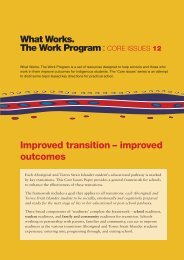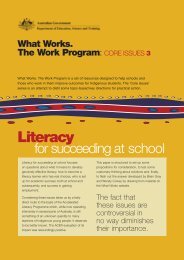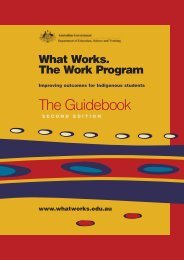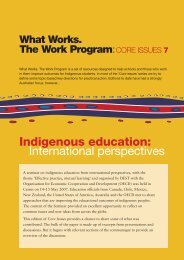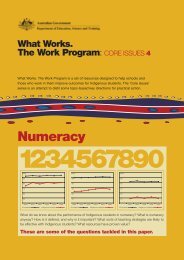Bound for Success Scope and Sequence Statements
Bound for Success Scope and Sequence Statements
Bound for Success Scope and Sequence Statements
- No tags were found...
Create successful ePaper yourself
Turn your PDF publications into a flip-book with our unique Google optimized e-Paper software.
ENGLISHSpeaking <strong>and</strong> ListeningIn Years 1, 2 <strong>and</strong> 3 students speak <strong>and</strong> listen through discussions, conversations <strong>and</strong> oral presentations in small <strong>and</strong> largegroups, which are usually in<strong>for</strong>mal. The students recount events <strong>and</strong> describe <strong>and</strong> report on people, places <strong>and</strong> thingsrelated to their own experiences.In Years 4, 5 & 6 students speak <strong>and</strong> listen through discussions, conversations <strong>and</strong> oral presentations in in<strong>for</strong>mal <strong>and</strong><strong>for</strong>mal contexts. The students provide explanations <strong>and</strong> <strong>for</strong>mulate simple arguments to explore in<strong>for</strong>mation, ideas <strong>and</strong>issues that extend beyond their immediate experience.In Years 7 & 8 students speak <strong>and</strong> listen through discussions, conversations <strong>and</strong> oral presentations including prepared <strong>and</strong>spontaneous discussions, meetings, debates <strong>and</strong> group discussions. Students examine ideas <strong>and</strong> in<strong>for</strong>mation <strong>and</strong> presentarguments that are drawn from topics of interest to them <strong>and</strong> that may need to be researched.In Years 9 & 10 students speak <strong>and</strong> listen through discussions, conversations <strong>and</strong> oral presentations that include meetings,extended presentations, <strong>for</strong>mal <strong>and</strong> parliamentary-style debates, <strong>and</strong> group discussions. They analyse <strong>and</strong> investigatechallenging ideas <strong>and</strong> issues <strong>and</strong> advance <strong>and</strong> refute arguments.In Year 1the student:In Year 2the student:In Year 3the student:In Year 4the student:In Year 5the student:In Year 6the student:In Year 7the student:In Year 8the student:In Year 9the student:In Year 10the student:underst<strong>and</strong>s that:o speaking <strong>and</strong> listeningprovides opportunities toshare in<strong>for</strong>mation <strong>and</strong>explore ideasunderst<strong>and</strong>s that:o speaking <strong>and</strong> listeningprovides opportunities toexchange in<strong>for</strong>mation, toshare <strong>and</strong> explore ideas,<strong>and</strong> to express opinions<strong>and</strong> listen to other’sopinionsunderst<strong>and</strong>s that:o speaking <strong>and</strong> listeningprovides opportunities toexchange in<strong>for</strong>mation, toshare <strong>and</strong> explore ideas,<strong>and</strong> to express opinions<strong>and</strong> listen to other’sopinionso they can adopt differentroles in discussions <strong>and</strong>conversations, <strong>and</strong> thatthese can support groupcooperationunderst<strong>and</strong>s that:o speaking <strong>and</strong> listeningprovides opportunities toshare <strong>and</strong> explore ideas,<strong>and</strong> to express opinions<strong>and</strong> listen to other’sopinionso people, places, events <strong>and</strong>things can be representedin either negative orpositive wayso delegation of roles <strong>and</strong>tasks is an element ofeffective groupdiscussionsunderst<strong>and</strong>s that:o speaking <strong>and</strong> listeningprovides opportunities toclarify ideas <strong>and</strong>underst<strong>and</strong>ings on a topic,to give simple arguments<strong>and</strong> to seek the opinionsof otherso people, places, events <strong>and</strong>things can be representedin particular wayso negotiation of roles <strong>and</strong>tasks are key elements ofgroup discussionsunderst<strong>and</strong>s that:o speaking <strong>and</strong> listeningprovides opportunities toexplore <strong>and</strong> considerideas <strong>and</strong> issues about atopic, <strong>for</strong>m a point ofview <strong>and</strong> influenceopinionso the likely characteristicsof the target audience aretaken into account whenconstructingrepresentations of people,places, events <strong>and</strong> thingso relationships betweenspeakers <strong>and</strong> theiraudiences vary withfamiliarity, authority <strong>and</strong>appealunderst<strong>and</strong>s that:o speaking <strong>and</strong> listeningprovides opportunities toexplore <strong>and</strong> considerideas <strong>and</strong> issues, advanceopinions, <strong>and</strong> influence<strong>and</strong> persuade others to apoint of viewo speakers use theirassumptions about thecharacteristics of listenersto engage interest <strong>and</strong>attentiono language can be adjustedto show or acknowledgepower, <strong>and</strong> to indicatecloseness or distance inrelationshipso some contexts requiremore <strong>for</strong>mality oflanguage than othersunderst<strong>and</strong>s that:o speaking <strong>and</strong> listeningprovides opportunities toexamine ideas <strong>and</strong> issues,make judgements in orderto challenge opinions <strong>and</strong>present different points ofview to persuade otherso speakers use theirassumptions aboutlisteners to influencepoints of viewo the <strong>for</strong>mality of languagecan be adjusted to suit therelationship between theparticipants eg to show oracknowledge power, toreflect closeness (Mymate’s hat looks cool.) ordistance (Mrs Jake’s hatis attractive.)underst<strong>and</strong>s that:ooospeaking <strong>and</strong> listeningprovides opportunities toexamine issues, evaluateopinions, argue points<strong>and</strong> make judgements −in order to persuadeothers <strong>and</strong> convincelisteners by usingreasoning <strong>and</strong> evidencespeakers use theirassumptions aboutlisteners to try toposition them to accepttheir point of viewhumour <strong>and</strong> drama areused as devices topersuade listeners <strong>and</strong> toentertainunderst<strong>and</strong>s that:o speaking <strong>and</strong> listeningprovides opportunities toanalyse other texts,entertain <strong>and</strong> persuadeaudiences, support astance on complexissues, interpret <strong>and</strong>evaluate texts <strong>and</strong> makeinferences about abstractconceptso speakers use theirassumptions aboutlisteners to position themto accept their point ofviewo humour <strong>and</strong> drama areused as devices topersuade listeners <strong>and</strong> toentertainspeaks audibly <strong>and</strong> listensattentively to:o make oral presentationso retell, in sequence, keyevents from personal <strong>and</strong>familiar experiences <strong>and</strong>interestso develop ideas orin<strong>for</strong>mation aboutpersonally relevant topicso make connectionsbetween their ownexperiences <strong>and</strong>representations of people,places, events <strong>and</strong> thingsin textso show respect <strong>for</strong> others inconversation through turntaking, eye contact <strong>and</strong>appropriate languagespeaks audibly <strong>and</strong> listensattentively to:o underst<strong>and</strong> the topic,make oral presentationsthat provide somerelevant ideas <strong>and</strong>in<strong>for</strong>mation, <strong>and</strong> includeevents in sequenceo develop ideas orin<strong>for</strong>mation aboutfamiliar topics orknowledge <strong>and</strong> personalexperienceo describe their ownopiniono identify <strong>and</strong> describeanother’s opinion heard ingroup discussiono show respect <strong>for</strong> otherswhen discussing personalreactions to people,places, events <strong>and</strong> thingsspeaks audibly <strong>and</strong> listensattentively to:o underst<strong>and</strong> the topic,make oral presentationsthat provide somerelevant ideas <strong>and</strong>in<strong>for</strong>mation , <strong>and</strong> includeevents in sequence <strong>and</strong>brief descriptionso address their audience <strong>and</strong>the needs of the listenerso identify opinionsprovided by members ofthe group in discussions<strong>and</strong> conversations,agreeing or disagreeingwith reference to theirpersonal opiniono show interest in aspeaker’s turn orpresentationspeaks audibly <strong>and</strong> listensattentively to:o extend ideas <strong>and</strong>in<strong>for</strong>mation with somedetails in small groupdiscussions or whenmaking presentationso consider the audience <strong>and</strong>the needs of the listenerso express opinions <strong>and</strong>identify viewpoints indiscussions <strong>and</strong>conversationso organise <strong>and</strong> sequencemain ideas <strong>and</strong> supportingdetail to suit text type <strong>and</strong>mediumo listen constructively <strong>and</strong>provide some positivefeedbackspeaks audibly <strong>and</strong> listensattentively to:o refer to main ideas, givepossible explanations <strong>and</strong>solutions, <strong>and</strong> supportthese with a few reasons –in small group discussionsor when makingpresentations on a topic orissueo speak with clarityo identify opinions offeredby others in discussions<strong>and</strong> conversations,propose other relevantviewpoints, or extendideas in a constructivemannero provide a logicalsequence of events whendescribing a process orexplaining a phenomenono listen constructively, <strong>and</strong>provide positive <strong>and</strong>encouraging feedbackspeaks audibly <strong>and</strong> listensattentively to:o identify main issues of thetopic <strong>and</strong> provide simplearguments, which mayinclude some supportingdetail <strong>and</strong> evidenceo <strong>for</strong>m <strong>and</strong> sustain a pointof viewo provide succinct accountsof important personalexperiences or eventso engage others byprojecting a sense ofcommitment <strong>and</strong> intereston a topico demonstrate respect <strong>and</strong>sensitivity towardsdifferent points of view,cultural values <strong>and</strong>perspectives of groups<strong>and</strong> individuals whenexpressing opinions <strong>and</strong>presenting argumentsspeaks audibly <strong>and</strong> listensattentively to:o identify main issues of thetopic <strong>and</strong> providearguments, which mayinclude some supportingdetails <strong>and</strong> evidenceo sustain a point of viewo provide succinct accountsof important personalexperiences or events <strong>and</strong>reflect on theirsignificanceo engage others byprojecting a sense ofcommitment, interest <strong>and</strong>authority on a topicspeaks audibly <strong>and</strong> listensattentively to:o identify main issues of thetopic <strong>and</strong> providearguments which includesupporting details <strong>and</strong>evidenceo respond to questions <strong>and</strong>comments by clarifying<strong>and</strong> paraphrasingo engage others byprojecting a sense ofcommitment, interest <strong>and</strong>authority on a topico exercise respect <strong>and</strong>sensitivity to differentpoints of view <strong>and</strong>cultural valuesspeaks audibly <strong>and</strong> listensattentively to:oooocompare ideas, build onothers’ ideas, provideother points of view <strong>and</strong>reach conclusions thattake account of aspectsof an issueanticipate responsesfrom others <strong>and</strong> respondto questions <strong>and</strong>comments by clarifying,paraphrasing, <strong>and</strong>integrating those ideasthat are relevant to a lineof reasoningidentify <strong>and</strong> comment onomissions in in<strong>for</strong>mationidentify <strong>and</strong> explore themoral <strong>and</strong> ethicaldimensions of an issuespeaks audibly <strong>and</strong> listensattentively to:ooooodecide how to argue,elaborate details oremphasise ideasin <strong>for</strong>mal situations,speakers maintain socialdistance through use ofan impersonal <strong>and</strong>/orauthoritative tonespeculate about what hasbeen excluded from thetextidentify <strong>and</strong> comment onthe moral <strong>and</strong> ethicaldimensions of an issueanticipate responsesfrom others <strong>and</strong> respondto questions <strong>and</strong>comments by clarifying,paraphrasing, <strong>and</strong>integrating those ideasthat are relevant to a lineof reasoningknows <strong>and</strong> uses:o statements to givein<strong>for</strong>mationo questions to requestin<strong>for</strong>mationo relevant vocabulary toknows <strong>and</strong> uses:o statements to expressopinion, arguments <strong>and</strong>present in<strong>for</strong>mationo questions to clarifyin<strong>for</strong>mation <strong>and</strong> gainknows <strong>and</strong> uses:o statements to expressopinion, arguments <strong>and</strong>present in<strong>for</strong>mationo questions to clarifyin<strong>for</strong>mation <strong>and</strong> gainknows <strong>and</strong> uses:o statements to providein<strong>for</strong>mation <strong>and</strong> expressopiniono questions to gainin<strong>for</strong>mation <strong>and</strong>knows <strong>and</strong> uses:o statements, questions <strong>and</strong>comm<strong>and</strong>s to generate<strong>and</strong> maintain discussions<strong>and</strong> conversationso specialist vocabularyknows <strong>and</strong> uses:o specialist vocabularyrelated to the topic −following researcho evaluative nouns, verbs<strong>and</strong> adjectives toknows <strong>and</strong> uses:o evaluative nouns, verbs<strong>and</strong> adjectives to expressopinions <strong>and</strong> to representpeople, places, events <strong>and</strong>things in ways that appealknows <strong>and</strong> uses:o evaluative nouns, verbs<strong>and</strong> adjectives toconstruct textualrepresentations of people,places, things, events <strong>and</strong>knows <strong>and</strong> uses:o structures of <strong>for</strong>malpresentations includingintroduction to an issue,arguments <strong>for</strong> <strong>and</strong>against, elaborations <strong>and</strong>knows <strong>and</strong> uses:o structures of <strong>for</strong>malpresentations includingintroduction to an issue,arguments <strong>for</strong> <strong>and</strong>against, elaborations <strong>and</strong><strong>Bound</strong> <strong>for</strong> <strong>Success</strong> <strong>Scope</strong> <strong>and</strong> <strong>Sequence</strong> <strong>Statements</strong> V2 Page 12 Working Document Semester One 2007



